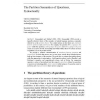Free Online Productivity Tools
i2Speak
i2Symbol
i2OCR
iTex2Img
iWeb2Print
iWeb2Shot
i2Type
iPdf2Split
iPdf2Merge
i2Bopomofo
i2Arabic
i2Style
i2Image
i2PDF
iLatex2Rtf
Sci2ools
CORR
2002
Springer
2002
Springer
The partition semantics of questions, syntactically
Groenendijk and Stokhof (1984, 1996; Groenendijk 1999) provide a logically attractive theory of the semantics of natural language questions, commonly referred to as the partition theory. Two central notions in this theory are entailment between sentences and answerhood. For example, the question Who is going to the party? entails the question Is John going to the party?, and John is going to the party counts as an answer to both. Groenendijk and Stokhof define these two notions in terms of partitions of a set of possible worlds. We provide a syntactic characterization of entailment between questions and answerhood. We show that answers are, in some sense, exactly those formulas that are built up from instances of the question. The result lets us compare the partition theory with other approaches to interrogation
| Added | 18 Dec 2010 |
| Updated | 18 Dec 2010 |
| Type | Journal |
| Year | 2002 |
| Where | CORR |
| Authors | Chung-chieh Shan, Balder ten Cate |
Comments (0)

